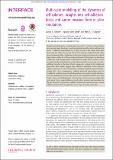Multi-scale modelling of the dynamics of cell colonies : insights into cell-adhesion forces and cancer invasion from in silico simulations
Abstract
Studying the biophysical interactions between cells is crucial to understanding how normal tissue develops, how it is structured and also when malfunctions occur. Traditional experiments try to infer events at the tissue level after observing the behaviour of and interactions between individual cells. This approach assumes that cells behave in the same biophysical manner in isolated experiments as they do within colonies and tissues. In this paper, we develop a multi-scale multi-compartment mathematical model that accounts for the principal biophysical interactions and adhesion pathways not only at a cell-cell level but also at the level of cell colonies (in contrast to the traditional approach). Our results suggest that adhesion/separation forces between cells may be lower in cell colonies than traditional isolated single-cell experiments infer. As a consequence, isolated single-cell experiments may be insufficient to deduce important biological processes such as single-cell invasion after detachment from a solid tumour. The simulations further show that kinetic rates and cell biophysical characteristics such as pressure-related cell-cycle arrest have a major influence on cell colony patterns and can allow for the development of protrusive cellular structures as seen in invasive cancer cell lines independent of expression levels of pro-invasion molecules.
Citation
Schluter , D K , Ramis-Conde , I & Chaplain , M A J 2015 , ' Multi-scale modelling of the dynamics of cell colonies : insights into cell-adhesion forces and cancer invasion from in silico simulations ' , Journal of the Royal Society Interface , vol. 12 , no. 103 , 20141080 , pp. 1-13 . https://doi.org/10.1098/rsif.2014.1080
Publication
Journal of the Royal Society Interface
Status
Peer reviewed
ISSN
1742-5689Type
Journal article
Collections
Items in the St Andrews Research Repository are protected by copyright, with all rights reserved, unless otherwise indicated.

